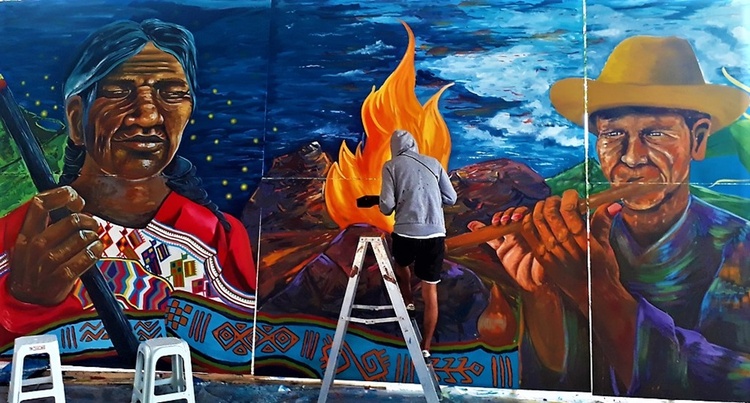
History of visual arts in Ecuador
The history of the visual arts in Ecuador is equally fascinating and diverse, with a rich artistic tradition that spans from pre-Columbian times to the present day. Here is a summary of the main moments and features:
1. Pre-Columbian art: Before the arrival of the Spanish, the Ecuadorian territory was inhabited by various indigenous cultures, such as the Caras, Quitu-Caras, Cañaris, Valdivia, Mantas and Incas, among others. These cultures produced a variety of art, including ceramics, textiles, stone sculptures, and precious metals. Highlights include the works of the Valdivia culture, known for its anthropomorphic and zoomorphic figures, and the Manteña culture, famous for its ceramic and goldsmithing works.
2. Spanish colonization: With the arrival of the Spanish conquistadors in the 16th century, European artistic influences were introduced, especially in the religious field. A school of colonial painting known as the Quiteña School developed, with works that combined indigenous and European elements. Artists such as Miguel de Santiago, Nicolás Javier Goríbar and Bernardo de Legarda stand out.
3. 19th century: During the 19th century, academicism and realism predominated in Ecuadorian art, with artists such as Antonio Salas, Rafael Salas and Manuel Samaniego. Representations of daily life, landscapes, portraits and historical scenes stood out.
4. 20th century - Avant-garde and modernism: In the first half of the 20th century, avant-garde and modernist movements emerged in Ecuadorian art, influenced by European and Latin American currents. Artists such as Eduardo Kingman, Oswaldo Guayasamín, Camilo Egas and Enrique Tábara stand out, who explored new forms of expression and social and political themes.
5. Contemporaneity: Today, the Ecuadorian art scene is diverse and dynamic, with artists working in a variety of media and styles, from painting and sculpture to conceptual art, installation and digital art. Contemporary artists such as Ana María Pacheco, Juan Villafuerte, Pablo Cardoso and Oswaldo Viteri, among others, stand out.
In summary, the history of visual arts in Ecuador is a reflection of its rich cultural heritage, with an artistic evolution that ranges from pre-Columbian expressions to contemporary trends, showing the creativity and artistic diversity of the country over time.

- July 11, 2025
Works by Six Latin American Artists

- July 11, 2025
IdN Magazine Volume 21, No.4 : Pattern Special

- July 11, 2025
Gallery of Posters by Daniel Warner from USA

- July 11, 2025
YEMEN


- July 10, 2025
IdN Magazine Volume 20, No. 1: Environmental Graphics




- July 10, 2025
The Evolution of Graphic Design from Ty…

- July 10, 2025
How Digital Artists Collaborate with Ar…

- July 09, 2025
The Value of Art in Education

- July 09, 2025
Art as a Reflection of Society

- July 08, 2025
The history of Bolivian art

- July 08, 2025
Protecting Art in the Age of Artificial…

- July 04, 2025
Graphic Design and Creating Iconic Bran…

- July 04, 2025
Photography as a Tool for Telling Histo…

- July 03, 2025
Painting and abstract art: differences …

- July 02, 2025
The Best Software for Digital Art and G…

- July 01, 2025
How Digital Artists Collaborate with Ar…

- July 01, 2025
Reflections of Digital Art in Different…

- June 30, 2025
Crítica de Obras Artísticas Criadas por…

- June 30, 2025
What are Plastic Arts?

- June 30, 2025
Images Against Silence: Artists Who Cha…

- June 29, 2025
History of Art Photography in the 20th …

- June 28, 2025
The 11 types of art and their meanings

- June 28, 2025
Contemporary Art is postmodern art

- June 26, 2025
Graphic Design, Art, and Technology: Wh…

- June 25, 2025
Graphic Design and Modern Content Creat…

- August 29, 2023
The history of Bolivian art

- February 19, 2024
Analysis and meaning of Van Gogh's Star…

- January 28, 2024
Culture and Art in Argentina

- September 25, 2023
What is the importance of art in human …

- September 23, 2023
What is paint?

- August 10, 2023
14 questions and answers about the art …

- August 30, 2023
First artistic manifestations

- August 23, 2023
The 11 types of art and their meanings

- September 23, 2023
History of painting

- January 12, 2024
10 most beautiful statues and sculpture…

- September 23, 2023
Painting characteristics

- August 16, 2023
The 15 greatest painters in art history

- April 06, 2024
History of visual arts in Ecuador

- March 26, 2024
The importance of technology in art1

- January 31, 2024
Examples of Street Art – Urban Art

- March 26, 2024
Cultural identity and its impact on art…

- January 20, 2024
What is the relationship between art an…

- April 07, 2024
Graffiti in Latin American culture

- October 21, 2023
Contemporary art after the Second World…

- August 25, 2024
A Comprehensive Analysis of the Cartoon…

- February 19, 2024
Analysis and meaning of Van Gogh's Star…

- August 13, 2023
9 Latino painters and their great contr…

- August 10, 2023
14 questions and answers about the art …

- August 29, 2023
The history of Bolivian art

- January 28, 2024
Culture and Art in Argentina

- August 23, 2023
The 11 types of art and their meanings

- November 06, 2023
5 Latin American artists and their works

- August 27, 2023
15 main works of Van Gogh

- September 23, 2023
Painting characteristics

- September 23, 2023
What is paint?

- September 25, 2023
What is the importance of art in human …

- December 18, 2023
10 iconic works by Oscar Niemeyer, geni…

- August 30, 2023
First artistic manifestations

- January 20, 2024
What is the relationship between art an…

- March 26, 2024
Cultural identity and its impact on art…

- January 12, 2024
10 most beautiful statues and sculpture…

- October 30, 2023
Characteristics of Contemporary Art

- August 22, 2023
What are Plastic Arts?

- April 16, 2024
The most important painters of Latin Am…

- August 24, 2023


